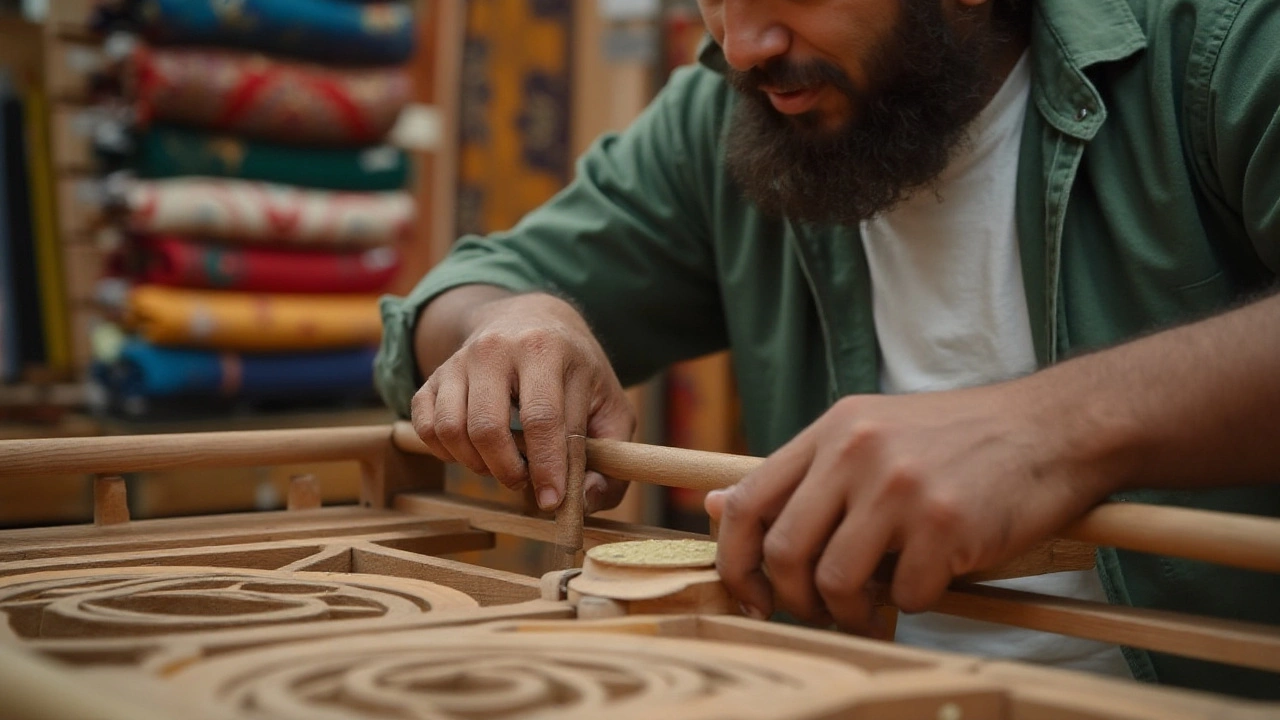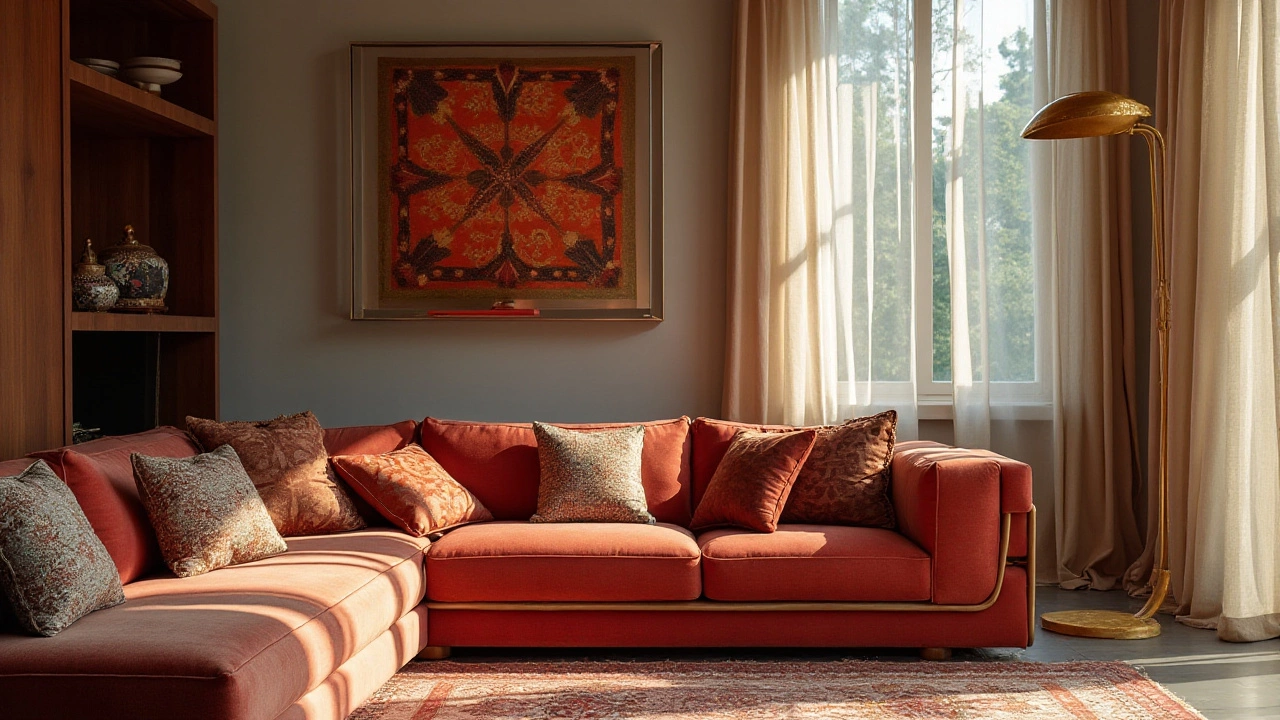When it comes to selecting a sofa that will stand the test of time, you need more than just a keen eye for style. It's about understanding what makes a sofa not only comfortable but also durable for years to come. From the frame to the upholstery, each element plays a critical role in its longevity.
Sofas are a centerpiece in living spaces, so balancing aesthetics with practicality is key. You'll want something that fits your space and lifestyle without compromising on quality. This guide delves into everything you should consider before making this significant furniture investment. With a few tips and the right knowledge, you'll be well on your way to finding a sofa that serves both form and function.
- Understanding Sofa Materials
- Evaluating Sturdiness and Comfort
- Assessing Upholstery and Cushion Quality
- Considering Style and Functionality
- Maintenance Tips for Longevity
Understanding Sofa Materials
Choosing the ideal durable sofa starts with knowing the different materials used in its construction. At the heart of any quality sofa is the frame, often made from hardwood, such as oak, maple, or ash, which ensures sturdiness and longevity. These woods are chosen because they are kiln-dried, removing moisture to prevent warping and twisting over time. For those looking for something on the economical side, frames made of engineered wood or plywood are common; however, they might not support the test of time like solid wood can. As you scout for the perfect piece, make sure to give the frame a jiggle—sturdiness is a solid indicator of a quality build.
Next, let's talk about the seating support. A legendary support system is the eight-way hand-tied springs, considered the gold standard in sofa engineering for ultimate comfort and durability. Though these might come at a higher price, they are worth the investment for someone who spends considerable time lounging. Alternatively, sinuous springs offer good support and are more budget-friendly, although they may not provide the same resilience and comfort. Beyond the frame and support, attention shifts to the cushioning. High-resilience foam is a popular choice, providing both comfort and longevity, while natural latex options offer a resilient, sustainable alternative.
Upholstery plays a pivotal role in both lifespan and aesthetic appeal of your sofa. Leather is often praised for its strength and easy maintenance, growing in character with age. There's a charm in a gently scuffed leather sofa that fabric simply cannot replicate. Fabrics such as cotton and linen provide a versatile option, especially when blended with synthetic fibers that enhance durability and stain resistance. According to a recent survey conducted by the Furniture Society of Australia, over 60% of buyers prioritize fabric's color and durability when selecting a sofa. On the other hand, for anyone seeking a cutting-edge contemporary look, microfiber textiles offer stain-resistance and easy cleaning, rapidly gaining popularity thanks to these features.
"The best material for your sofa is one that aligns with your everyday needs while ensuring the right balance between style and functionality." – Martha Simmons, Interior Design Expert
Incorporating diverse materials has its benefits as well. Some sofas come with metal or plastic legs, lending a modern touch while ensuring stability and strength. If your decor leans towards retro or industrial, these might be the elements that elevate your space, giving it an airy feel. Reviewing how these materials interact with your daily life and your other furniture can guide you toward the perfect choice. Remember, selecting a quality sofa is not merely about buying furniture; it’s about making an investment in comfort and style that lasts for years.
Evaluating Sturdiness and Comfort
When it comes to picking out a durable sofa that will serve you for many years, understanding the intricacies of its sturdiness and comfort is vital. It's not just about picking a piece that appears appealing at first glance; it involves delving deep into what holds it together and provides your seated bliss. One significant aspect to consider is the frame. Most experts agree that a quality wooden frame, preferably made from hardwoods like oak or kiln-dried wood, offers the foundation for a truly lasting sofa. Softwoods or metal frames might be tempting due to lower costs, but they often fail the longevity test under standard living conditions.
Another crucial aspect to examine is the support mechanism beneath those comfy-looking cushions. After all, the seat's resilience isn't just about the cushion's surface. Look for a sofa with a robust suspension system, such as eight-way hand-tied springs or sinuous springs that hold their shape, ensuring you don't experience the dreaded sagging effect. Some sofa aficionados might cite a 2019 survey which found that 70% of consumer complaints about sofas are linked to poor seat construction.
"A well-structured sofa should offer longevity while maintaining comfort. The frame and springs determine the lifespan," notes interior design expert Sarah Richardson.
As you delve deeper into the realm of comfort, focus not only on the heft of the cushions but on the materials used inside them. Opting for high-density foam that retains its shape and provides firm support is wise, but for added coziness, consider cushions that include a core of foam wrapped in down feathers. This combination strikes a balance between soft seating and resilient support. However, regular fluffing is needed to maintain its plushness. To cater to a range of preferences, some manufacturers offer modular sofas with interchangeable cushions, allowing you to tailor the comfort to your needs. Bear in mind, this flexibility can significantly enhance the lifespan of your preferred couch, making the investment all the more worthwhile.
Venturing beyond the technicalities, comfort is a subjective experience. Before you make the final decision, it's advisable to sit on the sofa, lounge in your typical manner, and mimic everyday usage, possibly with the family or a book. Imagine how you'd engage with this piece in your home setting. It's one thing to admire a sofa's sleek lines and chic design, and entirely another to feel its embrace as your go-to spot after a long day. A 2022 report mentions that about 40% of sofa returns stem from misjudged comfort levels upon delivery. This highlights the importance of considering personal comfort seriously before sealing the deal.

Assessing Upholstery and Cushion Quality
When it comes to selecting a durable sofa, the choice of upholstery and cushion quality can make all the difference. Upholstery fabric is not just about looks; it's also about wear resistance, maintenance, and how it complements your living environment. Linen, for example, offers a classic aesthetic and breathability, making it great for low-traffic areas. However, it tends to wrinkle easily. On the other hand, leather provides a sleek, elegant finish that only looks better with age, ideal for high-traffic zones. Yet, it requires dedication in care. To find a balance between convenience and style, microfiber and synthetic blends can deliver durability and a broad palette of colors, all while being child and pet-friendly.
Equally important are the cushions, which play a significant role in your sofa's comfort and longevity. High-density foam cushions offer a firm yet comfortable seating experience. Over time, low-quality foams might sag, leading to discomfort. To test cushion quality, press down on the foam and watch how quickly it regains shape. Rapid recovery suggests better resilience. For those seeking plush comfort, down-wrapped foam can offer a luxurious feel. However, regular fluffing and maintenance are needed to retain its shape and feel. According to furniture expert Jane Tarver,
"Investing in superior cushions is investing in enduring comfort and durability for your furniture piece."
And don't forget the details hidden beneath the surface. Often overlooked, cushion construction techniques, like the type of stitching and support systems used, greatly influence lasting quality. Double-stitched seams can handle regular wear and tear without fraying or splitting. Meanwhile, coil spring cushions offer increased lifespan and consistent support across many years. Consider your household's unique needs, like children or pets, while keeping in mind that balanced construction promises a long-lasting couch.
Upholstery and cushion quality intertwine with personal style and functional requirements. Those with a penchant for commercial-grade fabrics might enjoy the longevity they bring into a household setting. Recent studies reveal that such fabrics can withstand repeated rubs, often up to 50,000 double rubs, ensuring exceptional durability. Below is a simple guide to some common upholstery materials and their characteristics:
| Material | Characteristics | Usage |
|---|---|---|
| Leather | Durable, easy to clean | High-traffic areas |
| Microfiber | Stain-resistant, wide color choices | All-purpose |
| Linen | Breathable, prone to wrinkles | Low-traffic areas |
In choosing the right upholstery and cushions, consider not just the immediate feel but also how these elements will stand up to time and usage. Your quest for the ideal quality sofa involves balancing aesthetic appeal with practical functionality, ensuring you make a savvy investment in comfort and style.
Considering Style and Functionality
When choosing a sofa, style and functionality walk hand in hand. It's not just about picking something pretty, but about finding a piece that fits seamlessly into your life. Imagine coming home after a long day, looking forward to sinking into the plush cushions of your possibly modern or maybe timeless sofa. But what if it clashes with the rest of your room, or worse, doesn't serve the purpose you need? Here, we'll guide you through making choices that blend aesthetics and practicality.
Your sofa should be an expression of your taste, yet serve all functional needs. Think about your lifestyle. Do you need ample seating for family movie nights? Perhaps a sectional with a chaise could be the solution. Or maybe you're living solo in a cozy apartment where a compact two-seater is ideal. Each type of sofa brings its own merits. A great example comes from Ms. Emily Henderson, an interior designer, who often states,
"A good sofa is one that you love to look at but also love to live in."
The style should also echo the room's existing theme. Consider the color and pattern; a classic leather sofa may exude elegance, while a bright fabric option could add a pop of personality. Don't just look at the sofa in isolation—picture it in your living environment. Does it complement or contrast the other pieces in your room? A harmonious balance can greatly enhance your living space. You should also consider how trends might change, and think about opting for styles with some lasting appeal.
Functional aspects vary from practicality to day-to-day needs. Storage sofas are a boon for compact living spaces, offering hidden compartments while maintaining a sleek appearance. Sofa beds can be a lifesaver if you host guests often but lack a dedicated guest room. Need to accommodate growing kids or pets? Opt for forgiving materials like microfiber or leather, known for their resilience and ease of cleaning. These choices help the durable sofa fit into your life without adding unnecessary stress.
Lastly, beware of the hidden potential of customizations. Many manufacturers offer options to adjust sofa features—right from cushion softness to armrest height, ensuring it fits your unique comfort needs and lifestyle. It's not uncommon to find sofas with adjustable elements, such as removable cushions or modular pieces, that enable you to rearrange as per your needs—maximizing its utility. Investing in a long-lasting couch that aligns with your style and utility priorities ensures your living space is a testament to both taste and practicality.

Maintenance Tips for Longevity
Ensuring your sofa maintains its charm and comfort over the years requires attention and a few straightforward habits. Regular maintenance isn't just about keeping it clean; it also involves preserving its structure, which can significantly enhance your durable sofa investment. One fundamental step in sofa care is routine vacuuming with an appropriate attachment. Over time, dust and debris can settle into the fabric, gradually diminishing the vibrancy of the upholstery and potentially causing wear. By vacuuming weekly, you help mitigate this, keeping both the surface and the deeper fibers fresh.
Another key aspect of sofa maintenance is addressing spills promptly. Accidents happen, especially in a bustling household, and how quickly you react can make a big difference. If a drink is spilled, dab (don't rub) with a clean, absorbent cloth to avoid the liquid seeping deeper, which can stain or degrade the material. For fabric sofas, investing in a good fabric protector can be worthwhile; it adds a layer of defense against everyday mishaps. Leather sofas, on the other hand, have their own needs. They benefit from being kept away from direct sunlight and having a regular application of a leather conditioner. This prevents cracking and keeps the leather supple and beautiful, adding years to its useful life.
A critical factor in prolonging the life of your sofa is cushion care. Flipping and rotating cushions regularly ensures even wear, particularly for couches that get heavy daily use. Over time, this habit prevents sagging and keeps the seating cozy and supportive. Plus, if your cushion covers are removable, washing them occasionally following manufacturer instructions maintains their look and feel. For more permanent coverings, professional cleaning once or twice a year will keep everything fresh.
"Preserving quality furniture is about regular, simple care. Think of it like maintaining a car; little consistent efforts extend its life," says homeware expert Grace Chen.
To go a step further in maintenance, consider how you can protect the sofa from scratches or tears. If you have pets that love to hop on and off, like my curious cat Whiskers, keep their claws trimmed and maybe provide them with a comfy bed nearby to divert their attention. Speaking of pets, using machine-washable throws not only adds a dash of style but also an extra layer of protection from pet hair and daily wear. It's these thoughtful steps that truly enforce the long-lasting couch premise.
Finally, keeping your sofa in optimal condition sometimes means addressing its placement within the home. Avoid placing it too close to heating sources or air conditioning units, which can age the materials prematurely. A bit of strategic planning goes a long way to ensure your quality sofa remains a beloved piece of your home decor. With these practical guidelines, you can enjoy both comfort and durability, preventing the need for frequent replacements, and thus enjoying your perfect sofa choice for years to come.

